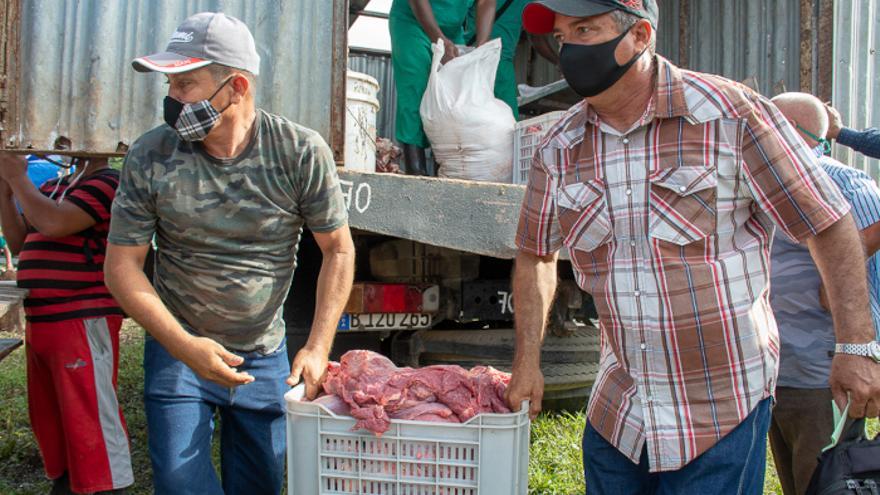
14ymedio, Havana, 7 June 2021 — Around 6% of Camagüey’s cattle ranchers will be able to eat their cattle and sell them, according to the calculations of the authorities. The province, historically the one with the greatest potential for the sector, celebrated in style over the weekend the first slaughters and sale of meat of the farmers who have complied with the government requirements that allow their cattle to be disposed of once they meet their commitments to the state.
Rubén Pérez Benítez, one of those farmers, enthusiastically told the local press that it was “a dream come true” that prompts the workers of his family farm to continue striving to have a surplus again next year. “It is a pride for the farmers to be able to slaughter their animal to feed the family. We did not do anything extraordinary, we increased the animals in general and the heifers, we also fulfilled the 38,000 liters of milk that we had under contract and with the beef too,” he explained to Adelante.
In April, the Government announced a package of 63 measures in order to stimulate food production that included, as a key measure for what was expected, the liberalization of the slaughter, consumption and sale of beef, as well as milk.
In May, the evaluation of the activity of the ranchers began in 2020 to give the authorizations and, according to Adelante , 600 ranchers in Camagüey comply. Taking into account that last year the authorities estimated that some 10,000 families make a living from livestock in the province, only 6% of them are in a position to sell their surpluses. A figure, at least, higher than that of Sancti Spiritus, where those who meet the requirements do not reach 1%.
On Saturday, the first six specimens, belonging to the José Antonio Echeverría Credit and Services Cooperative (CCS), from the Camagüey municipality, and the management of the Triángulo Tres Agricultural Company were slaughtered with great fanfare. At the “event” 3 pounds of beef were sold to each of the 358 homes in Los Pinos and the same amount was donated to 15 vulnerable families.
Pérez Benítez, from the El Sueño farm, said that on his property there are 120 animals, of which 42 are cows and that just as he has achieved this milestone, others can do it if they work. “We still have seven animals to slaughter in the remainder of 2021 and we are going to do it when we want, we only have to make the request and in a week at the most it is done,” he congratulated himself.
The Adelante newspaper also spoke with Julio Cabrera, a farmer and president of the José Antonio Echeverría cooperative, who considered it a “point of pride” that the farmers have contributed 100 pounds of beef with an agreed price of 60 pesos per pound of meat, 20 for veal and 15 for red bone.
“You have to be efficient and have control over the masses to be able to enjoy the benefits of them. We have to change the mentality now. They are revolutionary measures within the Revolution,” he claimed in a redundant boast.
The official newspaper itself admits at the beginning of the article how unusual it is that this information is newsworthy. “That livestock farmers slaughter animals from the herd for consumption or commercialization is not news in the rest of the world; but as we well know, our archipelago is full of incredible, unimaginable, enchanting singularities, and others that are absurd, why not?” the text reads.
The province of Camagüey, due to its expanse and soils, has led the sector throughout history. In 1953 there were 1,103,000 head of cattle, 27.4% of the country’s total. In 2020, however, there were 600,000, a year in which 41,000 animals died, most of them from malnutrition.
The data from last year in the livestock sector were devastating. In the first semester, the province registered the death of 17,000 cows due to malnutrition and a 30% decrease in milk production. To this was added the low birth rate, which resulted in 5,982 fewer head of cattle than the previous year. All this despite the fact that Camagüey with more families involved in a project of the International Fund for Agricultural Development (IFAD), of the UN, which was approved in 2016 and will last until 2024, at a cost of 50 million dollars.
The project aimed to “promote the sustainable growth of the livestock sector by increasing the production and sale of milk and meat,” as the activity “once flourished in the area” but “has declined since the 1990s due to the lack of investment.”
____________
COLLABORATE WITH OUR WORK: The 14ymedio team is committed to practicing serious journalism that reflects Cuba’s reality in all its depth. Thank you for joining us on this long journey. We invite you to continue supporting us by becoming a member of 14ymedio now. Together we can continue transforming journalism in Cuba.
